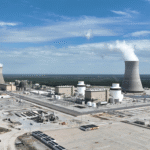Energy News Beat
The North American Electric Reliability Corporation (NERC) warned that more than half of the United States and parts of Canada, home to around 180 million people, could fall short of electricity this winter due to a lack of natural gas infrastructure. In its most recent winter outlook, the regulatory agency warned that prolonged, wide-area cold snaps could threaten the reliability of bulk power generation and availability of fuel supplies for natural gas-fired generation. The U.S. Midwest, Northeast, Mid-Atlantic, and South, along with some Canadian provinces, are at the highest risk. Grid operators are vulnerable to generators going offline under extreme cold conditions as there is not enough natural gas pipeline and infrastructure to serve all the gas generation in vulnerable areas. The situation has worsened under the Biden Administration due to its poor record on pipeline infrastructure construction, which in 2022 dropped to just 3 percent of the total constructed under President Trump in 2017. NERC also found that load forecasting in winter is growing in complexity and underestimating demand increases the risk to reliability in extreme cold temperatures.
New England’s Future Vulnerability
New England is particularly vulnerable since its natural gas infrastructure is very limited. And the reliability of its electric grid could get even worse next year. A possible loss of the Everett Marine LNG terminal could jeopardize the reliability of New England’s energy supply, according to the Federal Energy Regulatory Commission (FERC) and NERC. The LNG import terminal has been supporting natural gas supplies in New England since its first shipment over 50 years ago.
The 1,413-megawatt Mystic natural gas-fired power plant owned by Constellation Energy is scheduled to retire after May 2024. The plant is fueled by Constellation Energy’s liquefied natural gas (LNG) import facility on the Mystic River in Everett, Massachusetts. The company also provides natural gas from its LNG facility to gas providers in New England. The retirement plan could change, however, if the regional grid operator or another body determines the plant is required to preserve reliability or for other reasons.
EPA’s Pending Power Plant Rule
Further negatively affecting the future reliability of the U.S. electric grid is the Environmental Protection Agency’s (EPA) new rules for power plant emissions that is essentially forcing natural gas and coal power plants off the grid. Due to negative criticism of its rule, the EPA has recently conceded that it may need to rework its new emissions mandates due to potential grid reliability issues. In developing the rule, the EPA relied on assumptions regarding the viability of green hydrogen production and consumption as a replacement for natural gas and on the availability of carbon capture and sequestration technology, neither of which are commercially available today, among other issues with its methodology. The EPA plans to work with NERC and grid operators to ensure the new rules do not fragilize the grid. The concerns deal with compliance timelines, which begin taking effect in 2030, and what happens if carbon capture and hydrogen technologies are not available to meet those timelines as well as the need for more details on options states could use to develop plans for meeting the proposal’s requirements.
An analysis by Isaac Orr and Mitch Rolling indicates how devastating EPA’s new rules would be for the Midcontinent Independent System Operator (MISO). The authors modeled EPA’s rule and discovered massive capacity shortfalls because wind and solar are not producing enough electricity to keep the grid balanced. That is, there is not enough dispatchable capacity on EPA’s system to ensure the lights stay on. While EPA did build new natural gas peaking plants in its analysis of the rule, it did not build enough to replace retiring coal plants and meet future growing electricity demand when the wind isn’t blowing and the sun isn’t shining. The situation will only get worse as much of the Biden Administration’s vision of the “energy transition” relies upon increased use of electricity for heating, transportation, cooking, and everything else.
EPA expects weather-driven wind and solar power to show up when they are needed most, which does not happen in the real world. As a result, Orr and Rolling found that a 32 percent increase in installed capacity would be needed compared to EPA’s analysis. Building this capacity would cost MISO ratepayers an additional $246 billion ($7.7 billion annually) compared to EPA’s assumed grid, causing electricity prices for families and businesses to increase by approximately 32 percent. That equals about $170 every year for each of the 45 million people living in the MISO region or $680 per year for a family of four. Those are needless extra costs as the existing coal and natural gas plants in the region could operate for decades if it were not for the EPA rule.
December 2022 Storm
NERC wants to avoid a repeat of outages that occurred from last December’s storm. In September, FERC and NERC presented the results of their joint inquiry into the power outages and rolling blackouts during winter storm Elliott in December 2022. The inquiry found that the sub-freezing temperatures and extreme cold weather caused unplanned electric generation supply losses. Both electric and gas systems in much of the eastern half of the United States experienced significant stress, resulting in unplanned generation losses, with around 90,500 megawatts out at the same time. Flows of gas into pipelines were reduced, while demand for gas for heating and power generation increased, dramatically lowering line pressures. The gas system only narrowly avoided significant outages as pipeline operators “used all possible flexibility and storage withdrawals to deliver as much natural gas through the system as possible.” In New York City, Consolidated Edison declared an emergency because it faced a system collapse that would have taken “many months” to restore service in the middle of the winter, a potentially deadly outcome since so many more people die of cold than of heat.
Conclusion
NERC and FERC found that the United States needs more natural gas pipeline capacity to maintain reliable gas supply during extreme cold weather to prevent a repetition of last winter’s power outages. More natural gas pipeline capacity is needed to maintain a resilient system that affords homes and the power grid access to multiple sources of the fuel. Unfortunately, pipelines in this country are having a hard time being built. The 303-mile Mountain Valley natural gas pipeline, for example, was originally set for completion in 2018 and may finally be completed by early next year. Permitting delays and court action have increased the pipeline’s cost from the original estimate of $3.5 billion to $6.6 billion. Permitting reform is needed, but the Biden administration seems to only want it for development of “green technologies.”
The post NERC Warns of Potential Power Shortages This Winter amid Limited Natural Gas Infrastructure appeared first on Energy News Beat.








